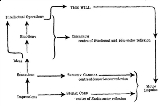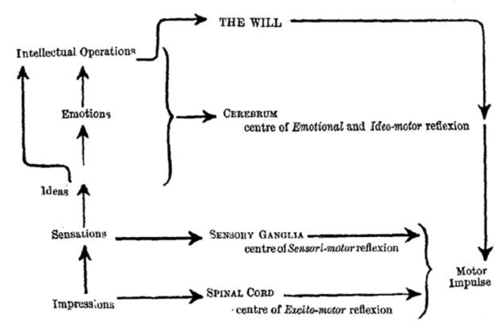
Suggestion
Encyclopedia
Suggestion is the psychological process by which one person guides the thoughts, feelings, or behaviour of another. Nineteenth century writers on psychology
such as William James
used the words "suggest" and "suggestion" in senses close to those they have in common speech—one idea was said to suggest another when it brought that other idea to mind. Early scientific studies of hypnosis
by Clark Leonard Hull and others extended the meaning of these words in a special and technical sense (Hull, 1933). The original neuro-psychological theory of hypnotic suggestion was based upon the ideo-motor reflex response
of William B. Carpenter
and James Braid.

have conducted experiments investigating such non-hypnotic-suggestibility and found a strong correlation between people's responses to suggestion both in- and outside hypnosis..
.
Psychology
Psychology is the study of the mind and behavior. Its immediate goal is to understand individuals and groups by both establishing general principles and researching specific cases. For many, the ultimate goal of psychology is to benefit society...
such as William James
William James
William James was a pioneering American psychologist and philosopher who was trained as a physician. He wrote influential books on the young science of psychology, educational psychology, psychology of religious experience and mysticism, and on the philosophy of pragmatism...
used the words "suggest" and "suggestion" in senses close to those they have in common speech—one idea was said to suggest another when it brought that other idea to mind. Early scientific studies of hypnosis
Hypnosis
Hypnosis is "a trance state characterized by extreme suggestibility, relaxation and heightened imagination."It is a mental state or imaginative role-enactment . It is usually induced by a procedure known as a hypnotic induction, which is commonly composed of a long series of preliminary...
by Clark Leonard Hull and others extended the meaning of these words in a special and technical sense (Hull, 1933). The original neuro-psychological theory of hypnotic suggestion was based upon the ideo-motor reflex response
Ideo motor response
The ideo-motor response , often abbreviated to IMR, is a concept in hypnosis and psychological research. It is derived from the terms 'ideo' and 'motor'...
of William B. Carpenter
William Benjamin Carpenter
William Benjamin Carpenter MD CB FRS was an English physician, invertebrate zoologist and physiologist. He was instrumental in the early stages of the unified University of London.-Life:...
and James Braid.
Hypnosis
Modern scientific study of hypnosis, which follows the pattern of Hull's work, separates two essential factors: "trance" and suggestion. The state of mind induced by "trance" is said to come about via the process of a hypnotic induction—essentially instructing and suggesting to the subject that they will enter a hypnotic state. Once a subject enters hypnosis, the hypnotist gives suggestions that can produce sought effects. Commonly used suggestions on measures of "suggestibility" or "susceptibility" (or for those with a different theoretical orientation, "hypnotic talent") include suggestions that one's arm is getting lighter and floating up in the air, or that a fly is buzzing around one's head. The "classic" response to an accepted suggestion that one's arm is beginning to float in the air is that the subject perceives the intended effect as happening involuntarily.
Waking suggestion
Suggestions, however, can also have an effect in the absence of a hypnosis. These so-called "waking suggestions" are given in precisely the same way as "hypnotic suggestions" (i.e., suggestions given within hypnosis) and can produce strong changes in perceptual experience. Experiments on suggestion, in the absence of hypnosis, were conducted by early researchers such as Hull (1933). More recently, researchers such as Nicholas Spanos and Irving KirschIrving Kirsch
Irving Kirsch is Associate Director of the Program in Placebo Studies and a lecturer in medicine at the Harvard Medical School and Beth Israel Deaconess Medical Center. He is also a professor emeritus of psychology at the University of Hull, United Kingdom and the University of Connecticut in the...
have conducted experiments investigating such non-hypnotic-suggestibility and found a strong correlation between people's responses to suggestion both in- and outside hypnosis..
Other forms
In addition to the kinds of suggestion typically delivered by researchers interested in hypnosis there are other forms of suggestibility, though not all are considered interrelated. These include: primary and secondary suggestibility (older terms for non-hypnotic and hypnotic suggestibility respectively), hypnotic suggestibility (i.e., the response to suggestion measured within hypnosis), and interrogative suggestibility (yielding to interrogative questions, and shifting responses when interrogative pressure is applied: see Gudjonsson suggestibility scaleGudjonsson suggestibility scale
The Gudjonsson suggestibility scale is a test that tries to measure how susceptible a person is to coercive interrogation.-History:It was created by Gísli Hannes Guðjónsson. It relies on two different aspects of interrogative suggestibility: It measures how much an interrogated person yields to...
.
External links
- Exploring the science behind hypnosis
- Self Mastery Through Conscious Autosuggestion A book on conscious autosuggestion by Émile Coué

